Chris Olsen has taken a new turn in his wind turbine experiments and built a direct drive neo magnet machine for use with the Midnite Classic controller.
Older stuff by Chris includes a gallery showing how to cut out a magnet disk with a cutting torch. Also his work with chain driven ferrite magnet machines on this blog here. And here
It is quite small for a 20 pole generator – only 330 mm rotors. The whole thing is covered to protect against snow and ice build up which has been a big problem in Chris’s Wisconsin environment.
2 x 1 x .5″ N42 bars with countersunk holes on both sides so they can be bolted to the rotors with small taper head stainless steel bolts. Air gap is 17 mm between magnet faces.
15 coils of AWG 14 wire for this stator and there is 70 turns in each coil.
Star/wye connected: 53 volts at 100 rpm and 205 at 380 rpm.
In delta: 120 volts from it @ 380 rpm.
The resistance: 1.13 ohm in wye and .35 in delta.
“I wanted to do a direct drive because I believe I will get better rotor acceleration with a direct drive to take advantage of variable winds. The geared machines “lag” a tiny bit when wind speed increases because the rotating mass must be accelerated much more than direct drive mass. I believe that will help me keep the rotor in a more ideal TSR range at all times, and harvest more energy from the wind. It might be very, very small amount. But over time it adds up. And when you have a wind turbine that already operates over 32% overall efficiency thruout the entire wind speed range, it gets harder and harder to “tweak” it to get more. So you have to pay attention to every last detail, including accelerating rotating mass!”
In these photos the generator has been modified to work well in star/wye with a 3.2 metre diameter rotor. “I pulled the rear generator rotor and added some shims to it to increase the air gap and lower the voltage some. Then programmed the controller to “flatten” the power curve and don’t let it go over 148 volts.”
- “I use these shims between the rotors to set the air gap”
- “This a shot for Hugh to show how close those mags run to the stator”
- “The stator will be 12mm thick after I get it out of the press, and I figured for a 17mm air gap”
- “the screens will fix the problem with the snow by just plugging up, and yet still allow air to flow thru for summer”
- “I put stainless steel bushings in the stator so the casting can’t be crushed, and use spacers and shims to set the stator to front gen rotor clearance. “
Chris has started a new web site with details of how to build this project here (but only the first pages are available)
“The Classic controller that boB and Robin Gudgel invented opened up a whole new world in what I can do in wind turbine design. I can “tweak” a power curve on my laptop and load it to the controller over wireless. Then sit there in the comfort of my office and watch it perform, and log the output data from it and analyze what the change did. It is very cool. And fun too! 🙂 “

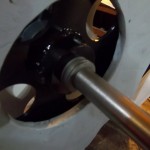
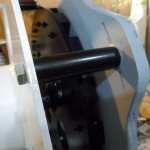
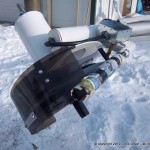
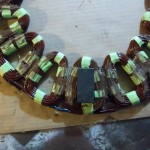
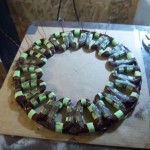
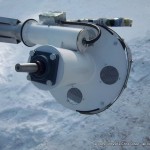
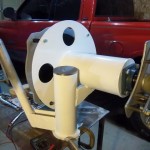
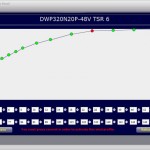

Chris tells me
“My old website is mostly intact on my own personal server now:
http://chriskristin.dlinkddns.com“
Hugh,
Just saw your reply! Unfortunately three years too late! I am still reading and re-reading old posts by Chris. Unfortunately that link takes me to an RC helicopter site? A bunch of Chris’s old post now have the pics missing. In any posts that linked a video none of the vidoes ever work!! This is such a HUGE loss to guys like me that are trying to learn everything we can!
Why is it folks like the one in Missouri will never shut up and guys like Chris, who we really want to hear from and have valuable knowledge, go off the res??
Two years too late!! Not AS bad as I thought! Haha
I have been reading tons of stuff from Chris Olson, but cannot find him anywhere. Links to what I think was his old website now send me to hurricane wind power for some reason. What is the story and how can I contact Chris nowadays? Does he have a new website?
Hi Chris
I have been a staunch supporter of your work. I take exception to the copiers of it for profit. I have recently slammed one of them. He is selling the design to someone else. That person does not deserve to have the product.
I admire true engineering being done. It shows logic and creative thinking.
CHRIS OLSEN, THANK YOU ALL FOR THE GOOD WORK YOU ARE DOING THERE. I AM A PRODUCT OF HUGH PIGGOTT!!!. I HAVE BUILD YOUR 20 MAGNETS, 48VOLT 4200 DIAMETER BLADE WIND TURBINE, WORKING FINE TO POWER MY HOME, BUT TO PUMP WATER IS MY PROBLEM AND PUMP CONTROL SYSTEM SIZE. HOW CAN L BUILD HORIZONAL AXIS WIND TURBINE WATER PUMP CONNECTED DIRECTLY TO AN ELECTRICAL PUMP FROM MY BORE-HOLE CAPABLE TO PUMP UP TO 5 OR MORE LITERS PER SECOND AT HEADS UP TO 80 METERS. I HAVE SOME MAGNETES N42 GRADE; 3INCH X 1.5 INCH BY 0.75 INCH BLOCK 60 Pcs, ROTOR BLADES3 3.05 METERS, BIG POLE 20 METERS TALL. ONE WATER PUMP AC 1 HORSE POWER SINGLE PHASE.
Hi – glad to hear you enjoy your new wind turbine!
I guess it has always been my opinion that a regular old water pumping windmill is the best for pumping water instead of using electric. My wife and I have an old Aermotor water pumper on our farm here that has been running and pumping water for cattle for over 50 years. I have had to replace bearings in it a couple times, and the leathers in the pump once. But it just chugs along and keeps on working.
One of the problems I see with using electric is the huge inrush amps that a 1 hp motor requires to start it. It could possibly work with a turbine charging batteries and use an inverter powered by the batteries to supply the surge power required to start the pump. But to hook it direct to an electric turbine, I don’t think, would work.
So I think I would recommend looking at purpose-built water pumping windmills that use a lift rod with a piston type pump.
Hi David,
I have been running the generators at 1,000-1,200 rpm on my geared machines. This direct drive is a very compact unit, only 330mm in diameter – actually smaller than the ferrite magnet geared turbines which use 355mm generator rotors. The mass of the ferrite magnet rotors is significantly more than these 330mm direct drive 20 pole rotors.
The math is quite simple. In order for the geared machines to increase only 20 rpm in rotor speed, the very heavy mass of the generator must be accelerated by an additional 50 rpm. The direct drive, with less rotating mass, will respond quicker to wind speed changes so the rotor does not drop out of ideal TSR range as easily.
Yes, diameter and mass are both functions of how much energy is stored (and absorbed in acceleration) in rotating components when angular velocity is increased. However, the generator mass of the geared machines is more than the mass of the turbine rotor itself. So I am confident this direct drive machine will outperform the geared machines.
—
Chris
Interesting comment about acceleration and direct drive vs chain drive. I don’t know whether this could be considered a clear cut issue. First, lightening the blades would be a more effective place to start because they would have the highest rotational inertia in the system. A comparison of wood densities vs strengths would be in order. Tapered blades would concentrate mass near the hub and reduce the rotational inertia. Then, building a direct drive generator would imply a mass increase, if we’re talking about maintaining the same rpm. To arrive at a definitive comparison, detailed calculations would need to be done.